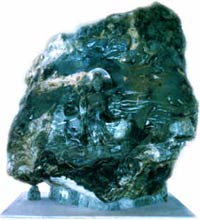Jade Masks
cctv.com 11-05-2004 09:50
Among the major exhibits showcased in many Chinese museums jade objects are certainly among the major ones and the earliest of these date back 8,000 years. The crafting of ornamental jade objects reached a high standard of workmanship during the 5th century BC but jade was already being used for burial objects in the Western Zhou Dynasty some 4,000 years ago.
Jade pieces made to resemble facial features were used to cover the faces of deceased kings and aristocrats. Typical jade masks for this use were found in a tomb of a Western Zhou Dynasty king unearthed in southern Shanxi Province.
LI JI (Vice Curator, Museum of Chinese History):
In a Jin State tomb unearthed in Houma in Shanxi Province, a couple of jade masks were discovered. A mask like this, placed on a piece of silk cloth covering the face, was actually composed of a number of jade pieces cut into the shape of of human brows, eyes, nose, mouth and ears. The pattern looks more or less like a human face.
Ancient Chinese believed jade, which symbolized status and good luck, was able to prevent the body of the deceased from decaying. The practice of using jade masks as burial objects lasted for over 2,000 years and reached its heyday during the Han Dynasty. Not only have jade masks been found from that period, but jade burial suits have also been unearthed in a number of places in southern China.
LI JI:
During the Spring and Autumn and Warring States periods or even earlier, jade masks were buried in the tombs of many aristocrats. Many believe the practice of clothing the dead in jade reached its pinnacle during the Western Han Dynasty. This is known as gold-threaded jade clothing. This demonstrates that covering the body with a jade mask and a few pieces of jade was no longer enough and that the practice of using jade as burial objects existed a long time ago. Thus just putting jade pieces under the body and covering it with jade were no longer considered enough to prevent it from decaying. It was from rom this reasoning that the unprecedented and unique jade clothing arose. Based on the thread used, there were gold-thread and silver-threaded jade clothes. In some jade clothing, neither gold nor silver was used, as in the case of the jade clothing found in a 5th century BC tomb unearthed south of Guangzhou. The jade clothing was sown with silk thread so itŌĆÖs called silk-threaded jade clothing. Jade was believed to help the soul live forever.
|

|
|
|
.
It usually took more than ten yearsŌĆÖ to complete just one piece of jade clothing, composed of hundreds of jade tablets. It was therefore considered more precious and more expensive than a jade mask. This unique practice of burying jade shows the special fondness ancient Chinese had for objects of jade.
Editor:Xiang Jing Source:CCTV.com